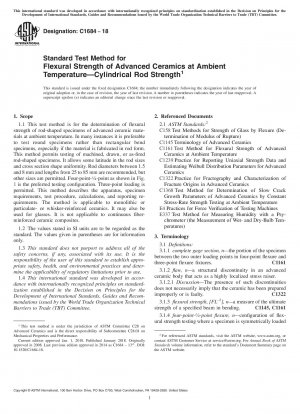ASTM C1684-18
Standard Test Method for Flexural Strength of Advanced Ceramics at Ambient Temperature&x2014;Cylindrical Rod Strength
- Standard No.
- ASTM C1684-18
- Release Date
- 2018
- Published By
- American Society for Testing and Materials (ASTM)
- Status
- Replace By
- ASTM C1684-18(2023)
- Latest
- ASTM C1684-18(2023)
- Scope
-
4.1 This test method may be used for material development, quality control, characterization, and design data generation purposes. This test method is intended to be used with ceramics whose strength is 50 MPa (~7 ksi) or greater. The test method may also be used with glass test specimens, although Test Methods C158 is specifically designed to be used for glasses. This test method may be used with machined, drawn, extruded, and as-fired round specimens. This test method may be used with specimens that have elliptical cross section geometries.
4.2 The flexure strength is computed based on simple beam theory with assumptions that the material is isotropic and homogeneous, the moduli of elasticity in tension and compression are identical, and the material is linearly elastic. The average grain size should be no greater than one-fiftieth of the rod diameter. The homogeneity and isotropy assumptions in the standard rule out the use of this test for continuous fiber-reinforced ceramics.
4.3 Flexural strength of a group of test specimens is influenced by several parameters associated with the test procedure. Such factors include the loading rate, test environment, specimen size, specimen preparation, and test fixtures (1-3).3 This method includes specific specimen-fixture size combinations, but permits alternative configurations within specified limits. These combinations were chosen to be practical, to minimize experimental error, and permit easy comparison of cylindrical rod strengths with data for other configurations. Equations for the Weibull effective volume and Weibull effective surface are included.
4.4 The flexural strength of a ceramic material is dependent on both its inherent resistance to fracture and the size and severity of flaws in the material. Flaws in rods may be intrinsically volume-distributed throughout the bulk. Some of these flaws by chance may be located at or near the outer surface. Flaws may alternatively be intrinsically surface-distributed with all flaws located on the outer specimen surface. Grinding cracks fit the latter category. Variations in the flaws cause a natural scatter in strengths for a set of test specimens. Fractographic analysis of fracture surfaces, although beyond the scope of this standard, is highly recommended for all purposes, especially if the data will be used for design as discussed in Refs (3-5) and Practices C1322 and C1239.
4.5 The three-point test configuration exposes only a very small portion of the specimen to the maximum stress. Therefore, three-point flexural strengths are likely to be greater than four-point flexural strengths. Three-point flexure has some advantages. It uses simpler test fixtures, it is easier to adapt to high temperature and fracture toughness testing, and it is sometimes helpful in Weibull statistical studies. It also uses smaller force to break a specimen. It is also convenient for very short, stubby specimens whic ......
ASTM C1684-18 Referenced Document
- ASTM C1145 Standard Terminology of Advanced Ceramics
- ASTM C1161 Standard Test Method for Flexural Strength of Advanced Ceramics at Ambient Temperature
- ASTM C1239 Standard Practice for Reporting Uniaxial Strength Data and Estimating Weibull Distribution Parameters for Advanced Ceramics
- ASTM C1322 Standard Practice for Fractography and Characterization of Fracture Origins in Advanced Ceramics
- ASTM C1368 Standard Test Method for Determination of Slow Crack Growth Parameters of Advanced Ceramics by Constant Stress Rate Strength Testing at Ambient Temperature
- ASTM C158 Standard Test Methods for Strength of Glass by Flexure (Determination of Modulus of Rupture)
- ASTM E337 Standard Test Method for Measuring Humidity with a Psychrometer (the Measurement of Wet- and Dry-Bulb Temperatures)
- ASTM E4 Standard Practices for Force Verification of Testing Machines
ASTM C1684-18 history
- 2023 ASTM C1684-18(2023) Standard Test Method for Flexural Strength of Advanced Ceramics at Ambient Temperature—Cylindrical Rod Strength
- 2018 ASTM C1684-18 Standard Test Method for Flexural Strength of Advanced Ceramics at Ambient Temperature&x2014;Cylindrical Rod Strength
- 2013 ASTM C1684-13e1 Standard Test Method for Flexural Strength of Advanced Ceramics at Ambient Temperaturemdash;Cylindrical Rod Strength
- 2013 ASTM C1684-13 Standard Test Method for Flexural Strength of Advanced Ceramics at Ambient Temperaturemdash;Cylindrical Rod Strength
- 2008 ASTM C1684-08 Standard Test Method for Flexural Strength of Advanced Ceramics at Ambient Temperature-Cylindrical Rod Strength

Copyright ©2024 All Rights Reserved